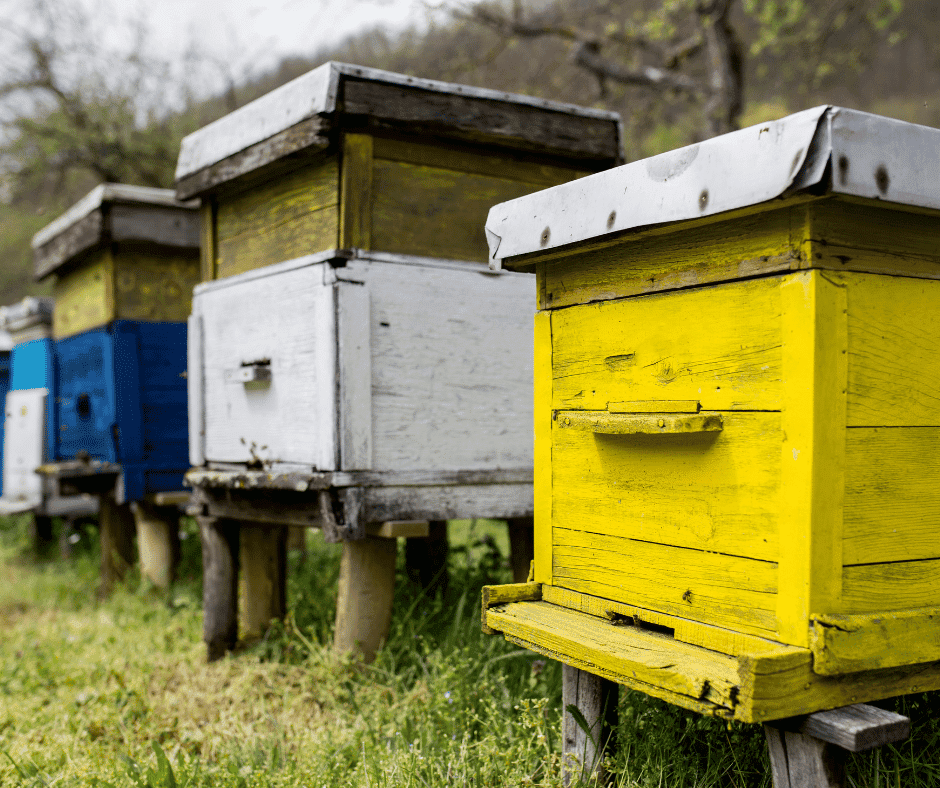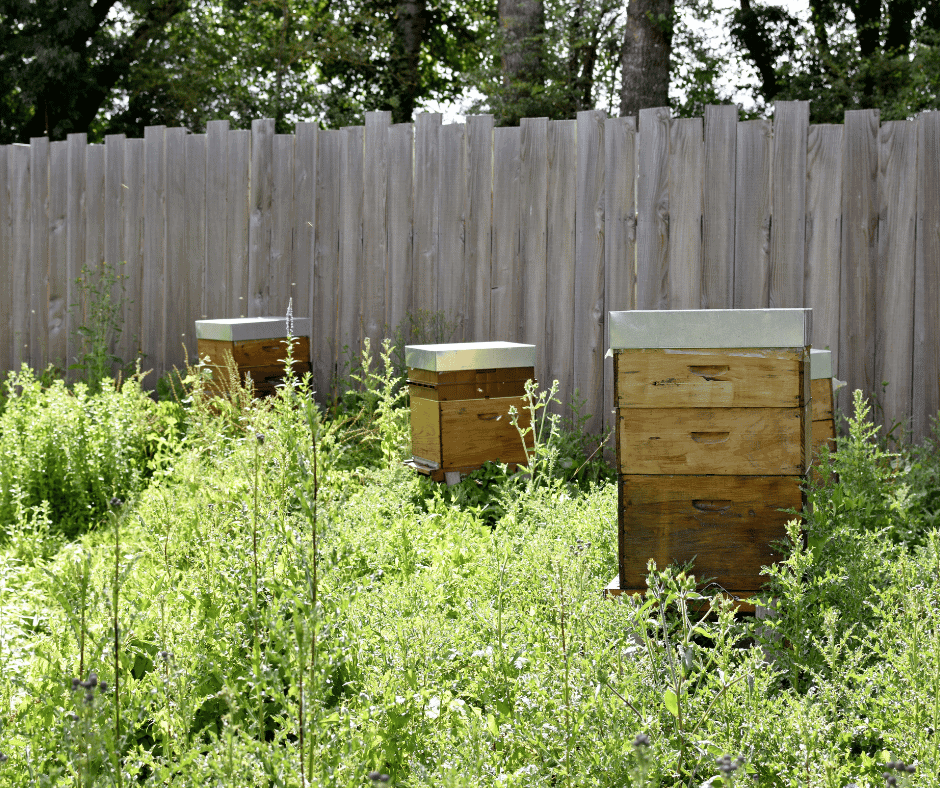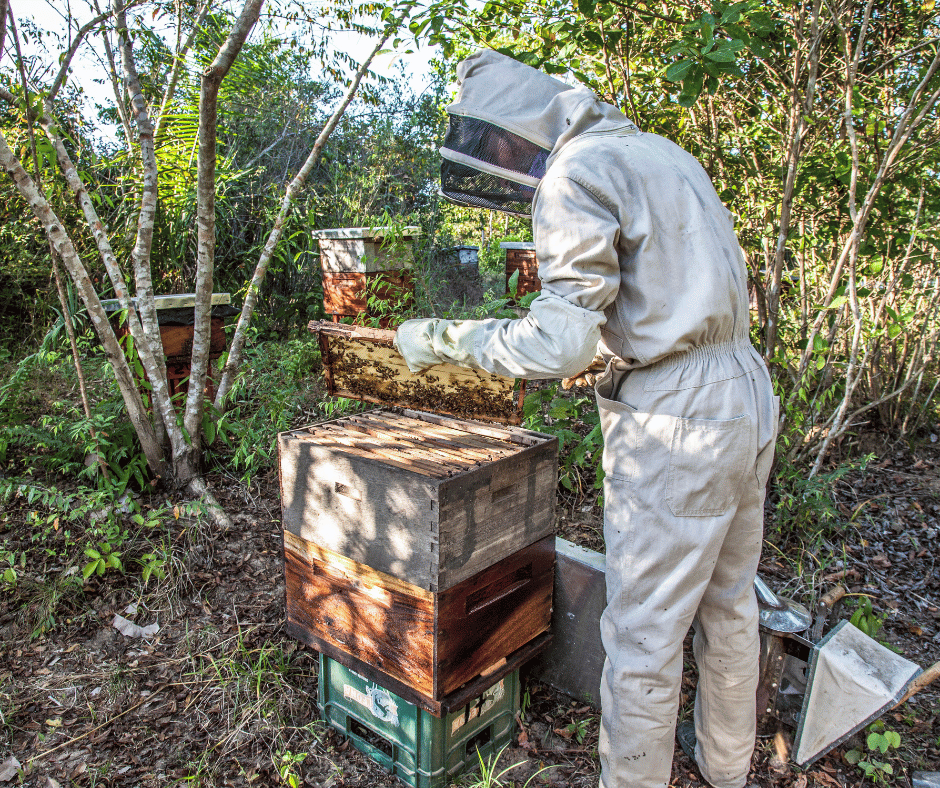
The thought of a beehive may conjure up images of a buzzing, chaotic mess that nobody in their right mind would want to get close to. But what if we told you that there are types of beehives out there that can provide us with an opportunity to enjoy this amazing hobby in safety?
From traditional European designs to the unique Warré hive, each type of beehive has something special to offer both beekeepers and curious observers alike. From providing honeycomb for delicious treats to allowing us to observe nature up close, understanding different types of beehives is beneficial for anyone looking to connect with the natural world around them.
In this article, we’ll delve into some of the most popular types of beehives, exploring their differences and how they support our relationship with bees and other pollinators. Get ready for a sweet journey through all things bee-related!
Table of Contents
Langstroth Hives

The Langstroth hive is the traditional bee hive and one of two main types of beehive used in modern beekeeping. It was designed by Rev. Lorenzo Lorraine Langstroth, an American entomologist who noticed that bees created natural compartments within their hives to store honey and raise young, a concept known as ‘bee space’.
Today it remains the most popular type of hive used by hobbyists and professional beekeepers alike. At its core, the Langstroth consists of boxes called supers placed on top of each other with wooden frames inside them containing wax foundation sheets for the bees to build their comb.
The structure allows for multiple layers or stories creating more room for the colony to expand without any additional effort from the beekeeper. This makes it easier to harvest larger amounts of honey than other bee frame types like Warré Hives or Top Bar Hives can provide.
Ease-of-use and flexibility make Langstroth hives a great choice both for beginner beekeepers looking to get started with backyard apiaries as well as experienced professionals managing large colonies across many locations.
With proper maintenance, these hives can last generations – allowing future generations to continue enjoying the sweet rewards of sustainable beekeeping!
Now we can take a look at Warré Hives – let’s examine how they differ from traditional Langstroths…
Warré Hives

The Langstroth Hive has long been the beekeeper’s go-to hive for honey production, but a growing number of beekeepers are turning to Warré Hives. A Warré is an innovative vertical beehive that was designed in France by Abbé Émile Warré and first published as “L’apiculture pour tous” or Beekeeping For All in 1948.
In its simplest definition, it is a wooden box with removable frames – allowing the use of the traditional methods of harvesting honey without the need to open up the entire hive. Images of Warré hives show multiple boxes stacked one on top of another, each containing nine frames – giving this style of hive its characteristic look.
This type of beehive offers numerous advantages over more conventional types such as increased insulation due to the stacking design, and easier maintenance since each frame can be removed individually instead of needing to take apart the whole structure.
It also allows colonies to move between boxes easily and encourages bees’ natural behaviors like swarming when needed.
Rather than relying on man-made structures, these newer hives allow bees space to build their own comb naturally while still providing access and protection from outside elements.
With its unique benefits, it’s no surprise that many beekeepers have turned towards Warré hives as an alternative method for managing their apiary – offering both convenience and sustainability all at once.
Moving forward, let us explore another modern invention – Flow Hives – which offer even more options for efficient honey production…
Flow Hives

Flow hives have revolutionized beekeeping. It’s the perfect combination of tradition and innovation, giving beekeepers an easy way to harvest their honey without disturbing the bees.
Flow hives offer several benefits that make them a great choice for both beginner and experienced beekeepers:
- No Need For Bee Suits – Unlike other types of beehives, flow hives don’t require protecting yourself from stings with additional clothing or equipment.
- Honey Harvesting Is Easy – Even if you’re new to beekeeping, getting your honey is as simple as turning a tap!
- Bee Hives In Trees Not Necessary– With traditional methods, you’d need to place your hive in trees which can be difficult depending on where you live; however, this isn’t necessary with a flow hive since there are no frames required to access the comb!
The modern design of these innovative hives makes it easier than ever before to start harvesting honey while taking better care of our buzzing friends! Whether you’re just starting out or want something more hassle-free, flow hives provide amazing advantages over other options available in beekeeping today.
The ease of use combined with its minimalistic design has made it incredibly popular among all kinds of beekeepers around the world.
Moving forward into the next section about top bar hives we’ll explore another type of hive that offers unique benefits compared to what we’ve discussed so far.
Flow Hive Video
Top Bar Hives

Moving on from the Flow Hive, we come to Top Bar Hives. A top bar hive is an open-ended bee box with a series of horizontal bars that provide structural frames for bees to build honeycombs off of and store their honey in.
This type of beehive is favored by more naturalistic beekeepers who wish to work with bees without disrupting them too much. It also allows for easier access for harvesting as it does not require taking apart the entire hive like most other hives do.
Additionally, many find these types of hives aesthetically pleasing due to their simplicity and minimalism; often consisting only of untreated wood thus avoiding any potential harm to the colony from chemicals contained in treated wood.
Furthermore, because there are no movable frames or foundations for comb construction, inspections can prove difficult at times since all parts must be examined first before making sure everything is alright throughout the whole bee box.
However, if done correctly, regular maintenance will ensure that your top bar hive remains healthy and strong over time – something every beekeeper strives for!
With just a few extra steps such as keeping up with mite treatments and monitoring general health through careful observation, you’ll have peace of mind knowing that your precious pollinators are safe and sound inside their cozy home.
As we move onto our next topic about modified Langstroth hives, let us remember how essential it is to protect our hardworking little friends when tending to their homes!
Modified Langstroth Hives
Modified Langstroth Hives are an increasingly popular choice among beekeepers looking to keep bees in a natural and efficient way. They provide the perfect balance between ease of use and practical features, allowing beekeepers to enjoy their hobby while still maintaining healthy hives.
Here’s why they’re so great:
- Modified Langstroth Hives offer easy access for harvesting honey since the frames can be removed individually with minimal disruption to the hive environment.
- Their design is based on classic Langstroth hives, but it has been modified to give more space for growing colonies without sacrificing ventilation or protection from pests.
- The boxes used for these hives also come pre-assembled, making them easier to install than other types of beehives.
- Additionally, these hives have a low cost compared to other alternatives like Kenya Top Bar Hives, making them more accessible for beginner beekeepers.
Overall, Modified Langstroth Hives strike a great balance between affordability and quality of life for both bees and beekeepers alike – something that all aspiring apiarists should consider when deciding which type of hive suits them best.
Next up we will take a look at the Kenya Top Bar Hives, we’ll explore how this unique style provides additional benefits…
Kenya Top Bar Hives

Beekeeping is an activity that goes back centuries, but new types of beehives are still being developed to make it easier and more efficient. Kenya Top Bar Hives (KTBH) are one such example. The KTBH offers beekeepers different advantages over other hives like the B box beehive in terms of cost and labor efficiency.
The design of a KTBH differs from most traditional bee hives because there are no moveable frames or foundation wax required. Instead, this type of hive consists of just one horizontal top bar which holds up the comb as bees build their own honeycomb along its length. This makes for easy harvesting without having to take apart multiple parts and frames within the structure.
In addition, these hives require less upkeep than some standard models, making them attractive to those who don’t want to spend lots of time maintaining the hive.
Still, they offer an affordable way to get started in beekeeping while giving you access to all sorts of interesting bee types in a single hive – something unique compared to other kinds on the market today. With careful use and maintenance, KTBHs can provide plenty of sweet rewards!
Moving on let us take a look at the Long Langstroth Hives…
Long Langstroth Hives

Moving on from Kenya Top Bar Hives, let’s explore the world of Long Langstroth hives. These are popular types of beehive frames among experienced beekeepers, who know and appreciate their many features.
Not only do these long hives for bees provide more space for a larger colony to thrive in than other types of beehives, but they also offer easy access for inspections and honey harvesting.
The design consists of several frames with horizontally-oriented bars that can hold multiple layers of comb. This makes it easier to remove individual combs without damaging the entire setup – something other types of beekeeping fail to achieve as easily.
On top of this, Langstroth hives have removable bottom boards which allow ventilation throughout the hive during hot weather.
In addition, these features of many a beehive come with plenty of room for expansion should you need it down the road.
Plus, adding extra boxes is an uncomplicated task even beginners will find simple enough to complete while still ensuring all safety measures adhere to.
With that said, we now turn our attention toward Dadant hives…
Dadant Hives

Dadant hives are one of the most popular types of bee hives and have been in use since their invention by Charles Dadant in 1867.
They quickly rose to prominence due to their ease of construction, as well as their ability to be stacked on top of each other – a feature that made them especially attractive for modern beekeepers who needed multiple hives.
The Dadant system consists of 10 wooden frames inside a rectangular box; bees create comb from these frames, storing honey and pollen within it.
It also provides ample space for bees to expand into larger colonies when necessary – something that can’t be said about some other types of beehives. However, its bulky size makes transportation difficult and some may find the assembly process daunting.
Overall, Dadant hives offer an excellent balance between efficiency and practicality and serve as a great choice for both hobbyists and professional beekeepers alike. Moving forward, we’ll look at horizontal top bar hives – another type of beehive with unique features suited to certain situations.
Horizontal Top Bar Hives
Let’s now explore the Horizontal Top Bar Hive. Much like its name suggests, this type of bee hive is horizontally arranged and contains top bars that provide a space for honey bees to build their combs in response to the environment they inhabit.
This design differs from other types of beehives because it allows honeybees greater freedom when constructing their combs.
The frames inside the box need not be uniform as with traditional ‘Langstroth’ or ‘Dadant’ hives; instead, they may vary in size and number depending on the needs of the colony within.
This makes them more suitable for apiarists who are interested in natural beekeeping practices since there is less interference by humans.
The Horizontal Top Bar Hive provides an ideal balance between convenience and practicality while allowing honeybees to live closer to how they would naturally—an advantage that has seen it become one of the most popular choices among novice beekeepers looking for a low-input way to manage their colonies.
But what about Skep Hives, I hear you ask?…
Skep Hives

The Skep hives of yore have been a mainstay for beekeepers since medieval times. A skep is simply an artificial beehive crafted from straw or some other material and hung in trees as apiary designs. It’s the kind of hive that often springs to mind when people think about bees; a quaint, rustic image of rural life.
| Types of Beehives | Advantages | Disadvantages |
|---|---|---|
| Skep Hives | Not very durable Needs frequent maintenance Cannot easily inspect inside without destroying the hive | Not very durable Needs frequent maintenance Cannot easily inspect inside without destroying hive |
For many beginning beekeepers, they’re an attractive option due to their simplicity and ease of construction—you could even say they offer a sense of nostalgia. However, there are still plenty of drawbacks associated with skep hives: namely that they need frequent upkeep, aren’t very durable over time, and require destruction if you want to check on your bees’ progress or health.
All these factors must be taken into account before deciding whether this type of beehive is right for you.
In summary, then, skep hives may provide a nice aesthetic but come with certain risks attached—in terms of both longevity and practicality. They’re certainly worth considering if you’re new to beekeeping but should not be relied upon solely for long-term success!
Video On Types Of Beehives
Conclusion
In conclusion, beekeepers have a variety of hives to choose from. It’s almost as if there are endless beehive types available!
From Langstroth Hives to Warré Hives, Flow Hives, and Top Bar Hives – the options seem never-ending. And that’s not even including Modified Langstroth Hives, Long Langstroth Hives, Dadant Hives, Horizontal Top Bar Hives, or Skep Hives either!
With such an abundance of choices out there, I’m sure any beekeeper will find a type of beehive suitable for their needs. What they all have in common is their ability to provide bees with safe havens where they can build homes and thrive.
Beekeeping has become increasingly popular over the years due to our need to protect these wonderful creatures we share this planet with.
We owe it to them (and ourselves) to make sure they’re kept safe and healthy by providing adequate housing solutions through various types of beehives.
By understanding more about different types of beehives and what works best for you, your colony, and your environment you’ll ensure that everyone involved benefits from the experience – leading us closer to creating a healthier world for both humans and bees alike!



